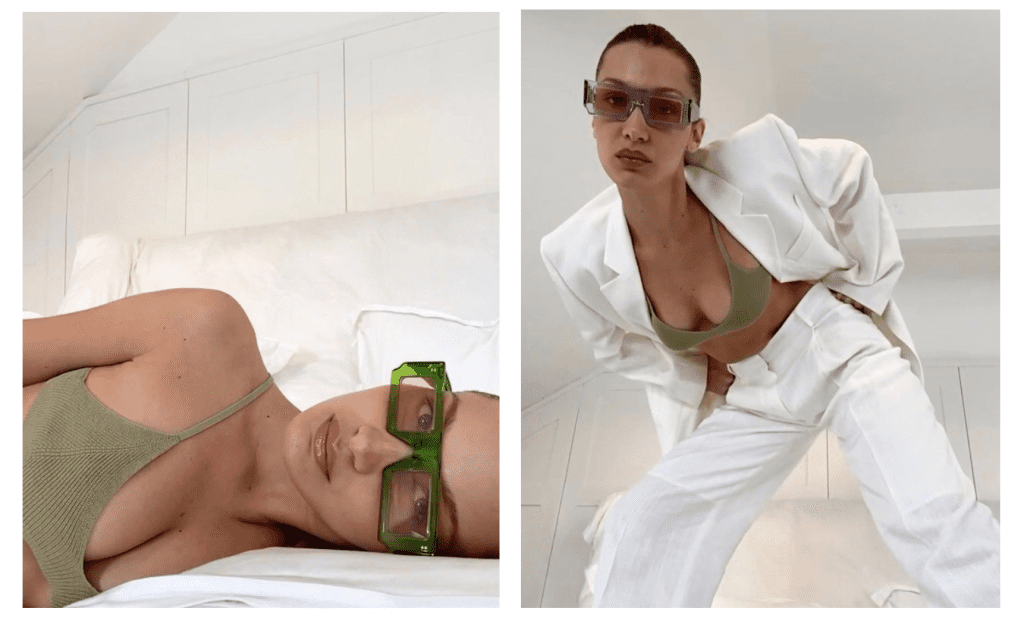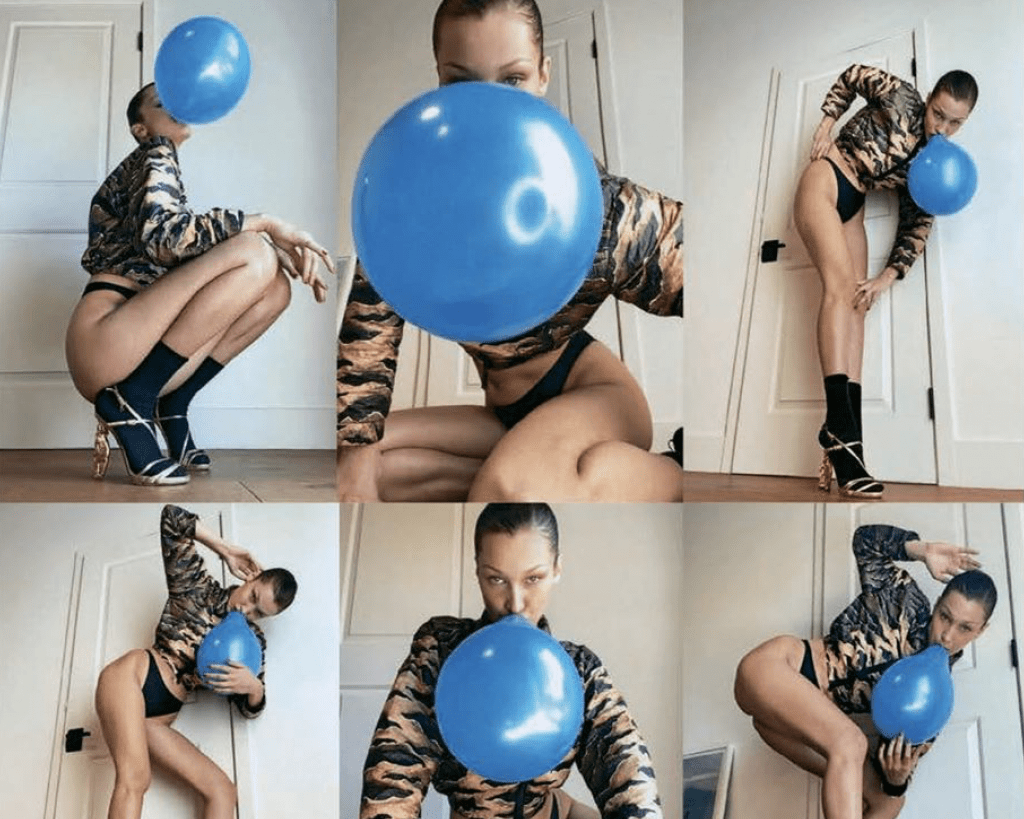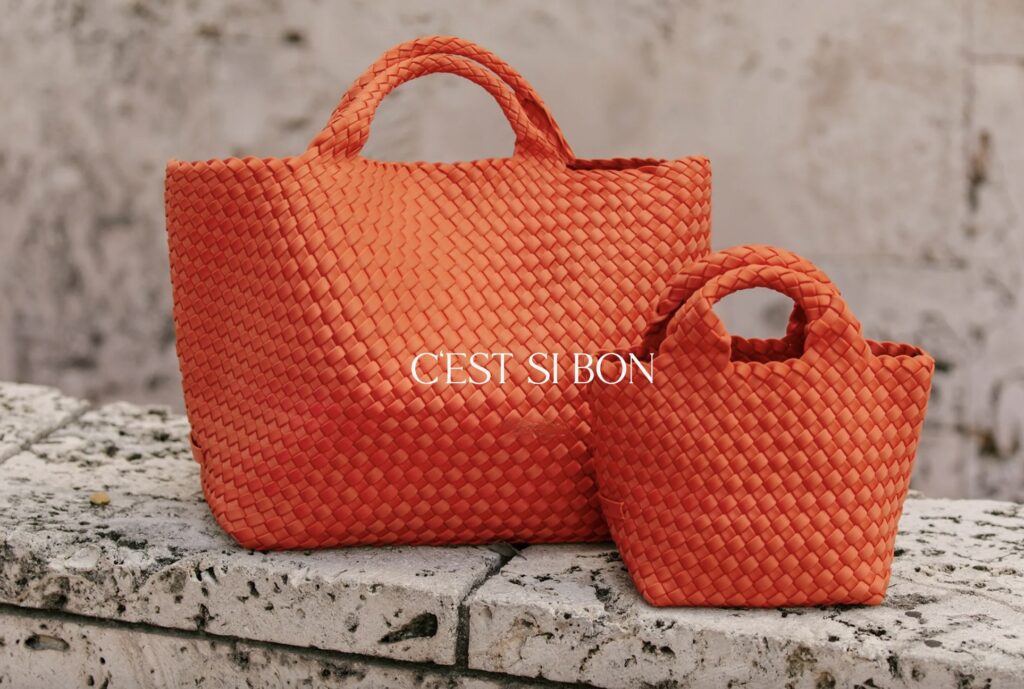In a new editorial spread for Vogue Italia, Bella Hadid poses in front of a white wall and doorway in strappy DSquared2 sandals, a camouflage-meets-animal print jacket, and itty-bitty bikini briefs, with a single prop in hand – err mouth: a blue balloon. Fast forward a few days, and the wildly in-demand model fronted the ad campaign for French designer Jacquemus’ Spring/Summer 2020’s collection, which consists of a roomy white suit, lavender and sunny yellow knits, rectangular lucite sunglasses, and sure-to-sell ombre patent leather Le Chiquito bag. Aside from their 25-year old supermodel subject, the two sets of images have something else in common: they were both shot entirely by way of FaceTime.
While models, designers, stylists, photographers, makeup artists, and all of the various essential assistants are shut-in at home thanks to the spread of the Coronavirus, fashion publishing and advertising has not stopped. Instead of calling it quits (temporarily), many fashion figures across the globe are looking to technology to help them churn out content and marketing materials during the COVID-19 shutdown.
For Vogue Italia, for example, this meant that photographer Brianna Capozzi, stylist Haley Wollens, and supermodel Bella Hadid connected via FaceTime to shoot the new editorial. According to Vogue that process went a little something like this: “The day before the shoot, Capozzi and Wollens tested poses on FaceTime (as they normally would in person). Then, they called Hadid for a fitting [of the clothing to appear in the spread].” On the day of the shoot, “Bella [did] her hair and makeup,” her friend Lauren Perez helped with the lighting, and they all signed on Apple’s video-calling service to shoot the imagery.
Capozzi said the shoot was fun, noting that “everyone’s opinions were considered” in creating and capturing the shots. In short: it sounds like the shoot was something of a collaborative effort, potentially more so than usual.
This digitally-centric effort is not limited to Hadid’s Vogue Italia editorial and extends to her Jacquemus campaign – which Vogue says was “captured by photographer Pierre-Ange Carlotti and creative-directed by its designer Simon Porte Jacquemus” – and a growing number of other editorials, including a recent spread in Vogue’s American publication. With the obvious roadblocks to traditional photoshoots that are currently in play, and considering how COVID-19 practices may play out after business goes back-to-normal, FaceTime photoshoots are being poised as the future of fashion photography, at least for the foreseeable future. Not only does this stand to change how fashion imagery is created, it raises some interesting questions from a legal point of view, namely, about authorship and ownership.
In terms of copyright law, the exclusive rights in a work – including the right to reproduce, display, and sell a work, etc. – are bestowed upon the “author” of the creative work, as the Copyright Act states that a work is fixed in a tangible medium of expression, a prerequisite to copyright protection, “when it [is] embodied in a copy or phonorecord, by or under the authority of the author.” When it comes to photos, the “author” is the photographer (at least initially), no matter who appears in the photo. In other words, rights are not granted on the basis of an individual simply being the subject of a photo.
This well-established fact has given rise to some pushback in recent years, in particular. As paparazzi-filed copyright infringement lawsuits have flood court dockets on both coasts of the U.S., the question of authorship – and thus, ownership – has proven to be an interesting one.
As counsel for Bella Hadid’s older sister (and fellow major-model) Gigi Hadid argued in one such suit filed against her, because “Ms. Hadid posed for the [paparazzi photographer] and thus, herself contributed many of the [creative] elements” in the photo, namely, her “pose, expression, [and] clothing,” she should be considered an “author” of the photo and have rights in it. (That case was ultimately dismissed after it was revealed that the plaintiff failed to receive a copyright registration in the photo prior to filing suit, as required by law).

The joint authorship argument is not entirely unheard of. It came up, to a certain extent, in Gillespie v. AST Sportswear when the U.S. District Court for the Southern District of New York held in 2001 that it would be possible for a jury to find that the subject of a photo is the “joint author of photographs where [he/she] contributed to ‘clothing’ and ‘poses’ of models.” Several years earlier, in 1992, the Second Circuit held in the Rogers v. Koons case that “elements of originality in a photograph may include the posing the subjects, lighting, angle, selection of film and camera, evoking the desired expression, and almost any other variant involved,” some of which could be contributed by the individual subject(s). And co-authoriship issues were also raised and examined by the Ninth Circuit in Garcia v. Google.
The rise of FaceTime and Zoom-orchestrated photo shoots comes about against this existing background of rising co-authorship arguments, and on Friday, University of New Hampshire School of Law professor Alexandra J. Roberts posed the question: “If the photographer can only direct a shoot remotely, (e.g. cannot physically adjust anything in the frame), does the model play a greater role in the collaboration and thus, merit co-author status in the expressive works created?”
Roberts notes that “certain variables change the analysis,” but “if [the parties are not using] a fancy remote-controllable webcam setup, then the photographer may control when to click [and capture the photo], but may be unable to manipulate the camera for angles,” for example. This could mean that the model might take on a more collaborative – and creative – role than she maybe otherwise would, which could create a greater level of authorship on the part of the subject, and thereby, entitle her to the same rights of authorship as the photographer.
In instances when the model actually takes the photo (and presumably, creatively contributes by way of other elements), some say the situation closely mirrors the famous “monkey selfie” copyright case. PETA, which filed the suit on behalf of Naruto, the monkey that snapped the photos, asserted copyright ownership in the images. Based on the fact that the photos were taken with his camera, counsel for photographer David Slater argued that he and his company, Wildlife Personalities Ltd., were the copyright holders of the photos.
Here, of course, “the subject of the photo,” who is a human and not an animal, “is legally capable of amassing copyright rights [if she] contributes creatively to the work,” says John Simpson, a copyright attorney and the founder of Shift Law. Although, Simpson cautions, “You’d want to put something [that recognizes that co-authorship agreement] in writing.”
Others note that the considerations at hand go well beyond such practical elements. Jeremy S. Goldman, a partner at Frankfurt Kurnit Klein & Selz PC, who focuses on intellectual property, states that “joint authorship requires objective manifestations of a shared intent [between the parties] to be co-authors.”
As for what such intent looks like, Dale Cendali and J. Michael Keyes assert in their work, Copyright Litigation Strategies, that “the expressions of intent that may give rise to a finding of joint ownership are most easily discovered by assessing the various tasks that are required to create the final product.” For instance, “In the clothing-advertising context, the relevant tasks that may express intent include selecting the models, clothing, poses, lighting, the type of camera and film, camera settings, and angles used to produce the final image.”
But even then, Goldman is skeptical of whether such co-authorship intent is present when it comes to the FaceTime-centric scenarios at hand, as he states, “If we are talking about a professional photographer, [it] seems very unlikely that he/she would intend to share authorship with the model.” And to date, there has not been any evidence that co-authorship agreements are creeping into major-models’ contracts with the likes of Vogue and co. in connection with these collective work-for-home projects in the already-very-collaborative field of fashion photography.
Ultimately, he says that “courts have made clear that creative contributions, no matter how important, are not enough to establish joint authorship when you cannot show control and intent.” With that in mind, “the fact that the model plays a bigger role in posing, setting up the shoot, etc., does not [necessarily] change things [in terms of authorship], particularly provided that the photographer has the final call and may never have intended to share authorship with the model.”
In terms of how significantly the rise of FaceTime photoshoots stands to impact the law in this area, Goldman says, “The law of authorship and copyright in a photograph has been the same since the Supreme Court considered these questions [in Burrow-Giles Lithographic Co. v. Sarony] back in 1884, particularly with its reference to the Nottage case from 1883. In my opinion, the fact that photographer and model are remote does not change anything.”











